T-capacitor
by Alexander V. Frolov
Now experimenting with asymmetrical electric capacitors
is well known as "Lifter" topic. What is the history of this research
and what is most perspective direction of its development? I'll try to
present my ideas on it.
Some experiments were produced in my laboratory from 1994.
The idea is to get asymmetry in the vectors of the field components. For
example, in classical plane capacitor the plates are in attraction but
the forces are contradicted. In T-shape capacitor two electrodes are placed
in the same flat.
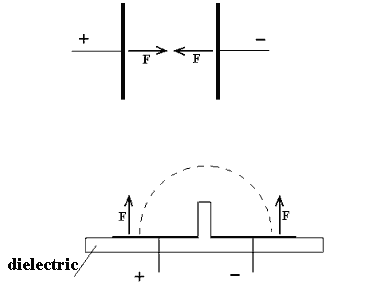
Fig.1
Electrodes are separated by "dielectric wall" to exclude
electric discharge along minimal distance way between electrodes. The electric
field structure is configured here to create co-directed electrostatic
forces for both electrodes.
Here is my article of 1994, published in USA and
Canada http://www.faraday.ru/pot.htm
"To discover a solution for a non-zero unilateral
resultant force, all we need is to note that the force line of the potential
field is always perpendicular to the charged surface and take advantage
of that fact."
Also comments by Thomas E. Bearden to this my paper
are quite interesting.
Some experiments in old Frolov's home laboratory,
1999
More data from Faraday Lab Ltd will be submitted soon
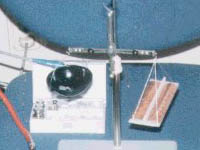

Small changes of weight of T-capacitor can be detected
with simple balance scales. Voltage is 10 kV.

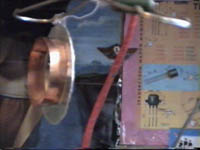
Rotation test in my home laboratory:
Look MPEG file here
Then the research group (Jean
Louis Naudin) from France
also experimentally confirmed this principle
(photos below). They named this asymmetrical capacitor as "Frolov's Hat"
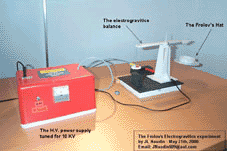
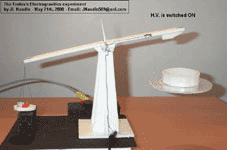

The technology also presented
by Transdimensional Technologies, USA
On July 6, 2001 Transdimensional Technologies, LLC will
unveil the next evolutionary step in propulsion. A small prototype "lifter"
will rise to the height of four feet without an engine, moving parts, conventional
thrust, or propellant. Application of this technology is possible within
one year, and a vehicle that is lifted and propelled by this force is possible
in three years. Transdimensional Technologies, LLC is a small company started
in Huntsville, Alabama in February of 2000. Physicist Jeffery Cameron is
Chief Scientist and inventor of this exciting and revolutionary technology.
After twenty years of research and study, Cameron conducted his first successful
experiments in his
garage, moving a plastic license plate a few inches with
this force. 1 1/2 years later, the lifter - built with aluminum foil, balsa
wood, and wire - is flying high.
The work of Mr. Cameron has been evaluated and verified
by a team of scientists contracted by NASA Langley. It is supported by
mathematical analysis and modeling that is verified within experimental
limits by actual demonstration. There is a pending patent.
http://www.tdimension.com/press_releases/press_release_6_25_01.html
Photo from Transdimensional Technologies,
USA
Version #3 by Jean Louis Naudin
16 g + 4 g of useful load

You can see video
of this experiment here
Problems and proposals for development
of the technology
This technology for commercial application
is very complex due to high voltage equipment. You can try to calculate
the lifting force for air asymmetrical capacitor (I made the calculations,
they are not perspective). So, we need other solution. In 1995 I proposed
the LIQUID DIELECTRIC version of the same asymmetrical capacitor. Now
we produced simplest tests in Faraday Lab Ltd. Some weight changes were
detected in experiments of Sept. 2001 with asymmetrical capacitor
(the jar and liquid oil dielectric):

Fig.4
Force about 0,4 gram was detected. Voltage 10 KV was applied
to the electrodes. Measurements were made with HL400EX digital scales.
But most perspective is research on SOLID STATE GRADIENTAL
DIELECTRIC. The work is very complex for our small private laboratory
since the problem is to get gradual changes of dielectrical permittivity
in dielectrical material between two plates of flat capacitor. But we are
sure in great commercial perspectives of this work and we continue the
experimenting on the topic.
The calculations seems to be very good http://www.faraday.ru/gradient.html










